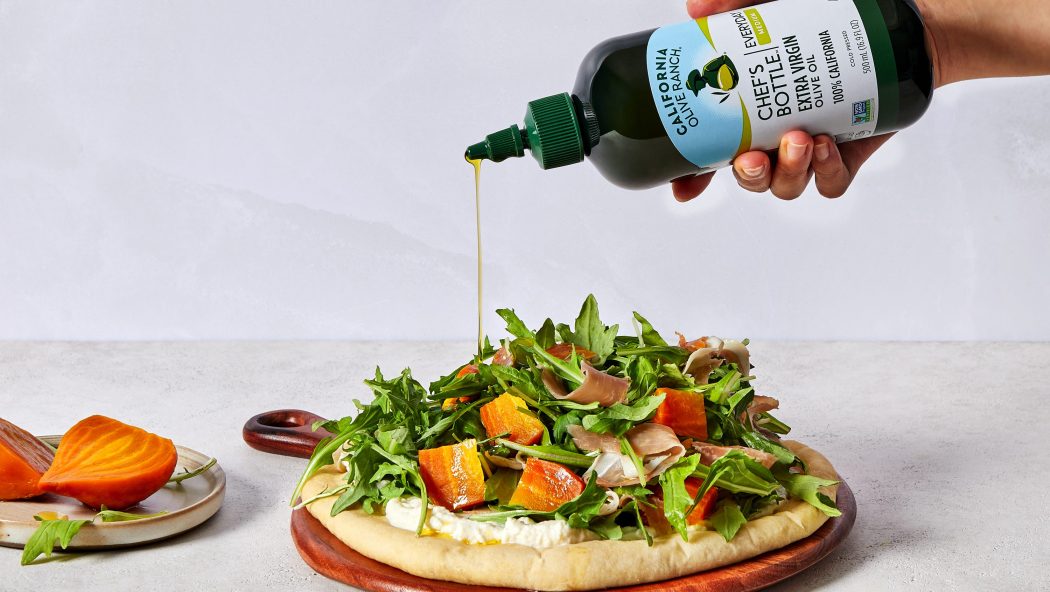To squeeze or not to squeeze: The olive oil world is divided over plastic packaging

The latest product launch at California Olive Ranch may look familiar to some olive oil fans. It’s a squeezable plastic 500 mL bottle, a design that encourages customers to “channel their inner chef” by squeezing the extra virgin olive oil into their pots, pans or recipes.
If it sounds familiar, that’s because it is — Michael Fox, CEO at California Olive Ranch, said the launch of the squeeze bottle in March came after customers began asking the company for one that was similar to Graza, a two-year-old olive oil company, offered.
“We got a lot of customers calling us saying, ‘Hey, when are you launching in California Olive Ranch squeeze bottle?'” he said.
Almost immediately, the “Chef’s Bottle” shot up to be the number two seller on the California Olive Ranch website, only behind its two-liter “bag in a box” bulk size. Fox said the Chef’s Bottle is slated for national distribution in Whole Foods and Kroger later this year.
“We think there’s room on the shelf for this package, and I think you’ll see it from others,” he said. “There’s room for a couple of squeeze bottles to be out there, just like there’s a lot of different glasses.”
The squeeze bottle, a staple in restaurant kitchens, hit the mainstream with Graza, a DTC and wholesale olive oil brand that came to market in early 2022. The new packaging style was a hit, and other companies started jumping on board — like Brightland, who created a “Pizza Oil” in a squeeze bottle.
Beyond consumer demand, the new product style is a way for companies like California Olive Ranch to diversify their product lines at a time when prices for olive oil are high. Droughts in Europe contributed to record-setting prices in 2023. That led to increased prices for brands, and in turn, consumers. The European Commission said earlier this year that prices there are 50% higher than they were last year.
California Olive Ranch, for its part, is insulated somewhat from this due to its vertically-integrated California-based olive oil farms. And Fox said units are still up, indicating demand for the product. The brand grew by 11% year over year based on sales last year and is trending 25% up through February of this year. But Fox said the state of the industry is such that large brands on supermarket shelves still have to innovate with new products and packaging to compete.
“I wouldn’t be surprised if a lot of folks come out with this in the future,” he said of the squeeze bottle, noting that he’s aware of at least one other oil brand that is plotting a launch. “And that’s why we wanted to kind of respond to our consumers and customers pretty quickly.”
Graza’s CEO and co-founder Andrew Benin didn’t respond to an interview request from Modern Retail for this story. Last spring saw an internet dust-up after Benin posted on LinkedIn about Brightland allegedly copying Graza’s design, though he later apologized. But Graza’s own marketing makes clear that the squeeze bottle is a part of their brand, with the tagline “Fresh Squeezable Single Origin Olive Oil” atop its Instagram bio. In the past, Benin described the squeeze bottle as “fun as hell to use.” With the eye-catching design becoming a cult favorite among foodies, the company has scored on scalability, gaining shelf space in national mass retailers like Target, Sprouts and Safeway.
But not every olive oil company is rushing to the squeeze bottle line.
At Kosterina, an olive oil company launched by Katina Mountanos in 2020, glass and aluminum are the sole packing materials. She said she won’t put the Greek-origin extra virgin olive oil in plastic due to concerns about preserving the health benefits of the product. “We would never do a squeeze bottle,” she said. “Olive oil should never be packaged in plastic.”
If customers want the experience of a squeeze bottle, she recommends decanting it into a squeeze bottle that can be used for a week or two at a time, versus buying it that way.
“It’s fun the way the plastic bottle came about from kitchens,” she said. “[Chefs] typically use a squeeze bottle in the back. But they’re refilling the bottle every day from a large tin. It’s not sitting for six to 12 months in a bottle.”
She admits she received some flack for her stance from others within the olive oil industry, as many are choosing to use plastic. But she points to the better-for-you, better-for-the-planet ethos that comes along with glass or aluminum. Tins are the most common way that olive oil has been packed in Europe, Mountanos said, because it is less expensive and lighter than glass.
For its part, California Olive Ranch is looking at product innovation as one of the key growth strategies for the company. The company, founded in 1998, has already added an avocado oil blend, sauces and vinaigrettes to its roster. But selling its staple olive oil in other forms is also a business driver. Its glass bottles come in a variety of sizes, plus it has a two-liter “bag in a box” format meant to cater to heavy users. Its aluminum tin came out in September 2022, and the chef’s bottle debuted in March.
“Plastic is very polarizing,” Fox said. “You get a lot of people who love the plastic and love the squeeze bottle because it’s fun and versatile., And then you have very vocal groups of people who hate it. We believe we have a wide portfolio of options for our consumer, and you’re going to us continue to stretch that as we go into different adjacencies.”
